Salmon Grilling Tips: Expert Techniques for Perfectly Cooked Fish
Grilling salmon can be a delicious and healthy way to enjoy this flavorful fish, but getting it just right can be a challenge. To grill salmon perfectly every time, preheat your grill to medium-high heat, around 375 to 450 degrees Fahrenheit. This ensures the salmon cooks evenly and gains a nice, charred exterior.
To prevent the salmon from sticking, rub it generously with oil and season it with salt and pepper. Use a piece of aluminum foil or grill directly on freshly cleaned and oiled grates. Grill the salmon skin-side down for 6 to 8 minutes per inch of thickness until the flesh turns opaque and easily flakes with a fork.
Brush your salmon with a tasty marinade, like a mixture of olive oil, mustard, and vinegar to add an extra layer of flavor. These tips will help you achieve a perfectly grilled salmon that’s juicy, tender, and packed with flavor. For more details, you can check out some great recipes and techniques from Ambitious Kitchen and Food Network.
Selecting the Best Salmon
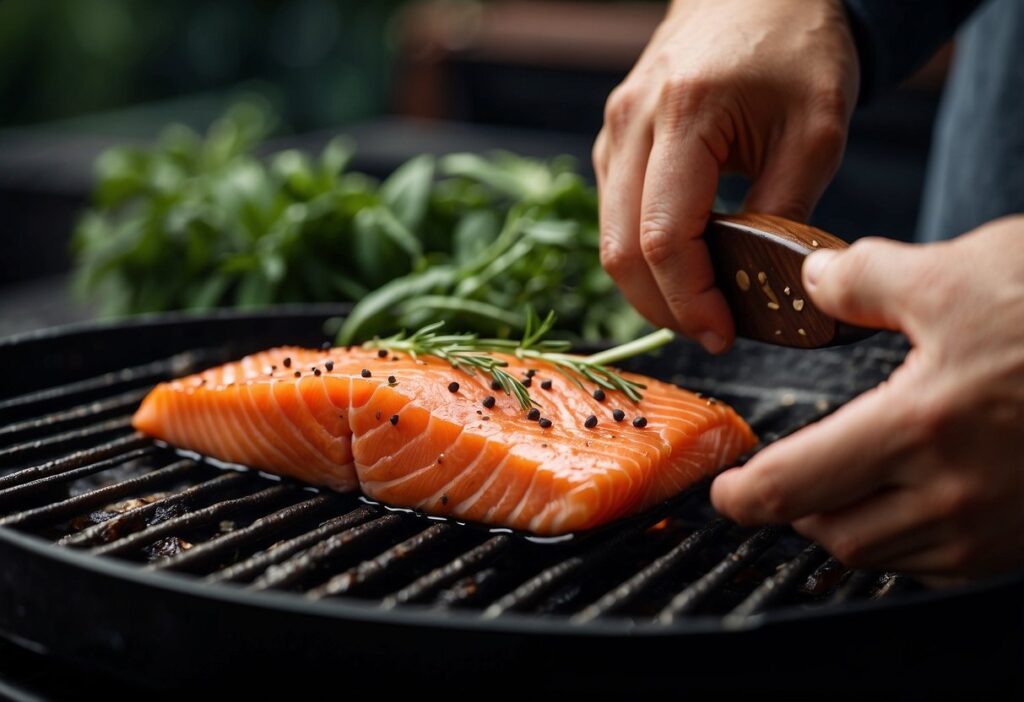
Choosing the right salmon involves understanding the differences between various types, knowing the pros and cons of farm-raised versus wild-caught options, and recognizing key features of fresh, high-quality fish. Let’s explore these aspects to help you pick the best salmon for grilling.
Varieties of Salmon
Understanding the different types of salmon can guide your selection. Chinook (King) salmon is prized for its rich taste and high fat content. Sockeye salmon has a firm texture and a bright red color, making it great for grilling. Coho (Silver) salmon is milder and often more affordable. Pink salmon, on the other hand, is less expensive and typically used in canned products. Each variety offers a unique flavor and texture, helping you tailor your choice to your recipe and taste preferences.
Farm-Raised Vs. Wild-Caught
When deciding between farm-raised and wild-caught salmon, consider several factors. Wild-caught salmon typically has a firmer texture and richer color due to its natural diet and active lifestyle. It’s often considered more environmentally friendly since it doesn’t require the resources used in fish farms. Farm-raised salmon can be more readily available and less expensive. However, it may contain higher levels of contaminants due to farming practices. Always check the labels and opt for responsibly farmed varieties if going this route.
What to Look for When Buying
When purchasing salmon, fresh or frozen, look for several key indicators of quality. Fresh salmon should have bright, clear eyes and shiny, moist skin. The flesh should be firm and bounce back when pressed. If you’re buying cut fillets, ensure they are bright in color, with no darkening or dry edges. For frozen salmon, check that the packaging is intact and free from ice crystals, which can indicate freezer burn. Smell is also an important factor; fresh salmon should have a mild scent, not a strong “fishy” odor.
By focusing on these details, you can ensure that the salmon you buy is of top quality, leading to a more enjoyable grilling experience.
Preparing the Salmon
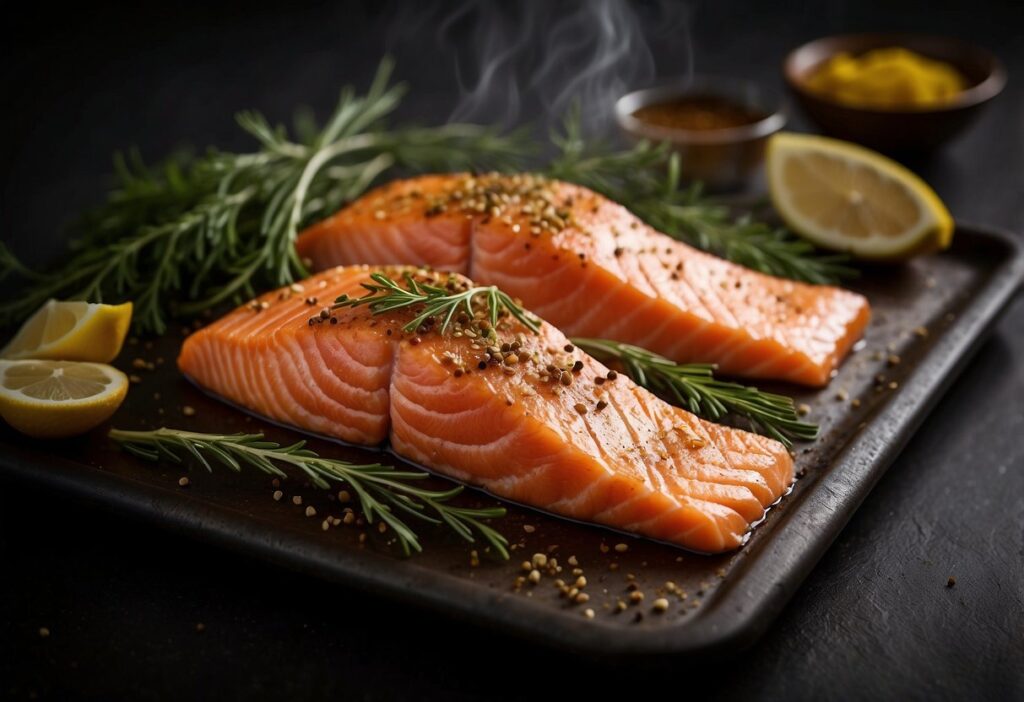
Grilling salmon involves selecting the right cut, deciding whether to leave the skin on, and using marinades to enhance flavor. Proper preparation ensures a tasty and well-cooked dish.
Salmon Cuts for Grilling
When choosing salmon, go for center-cut fillets. These cuts are uniform in thickness, ensuring even cooking. Center-cut pieces also tend to be more tender and flavorful.
Avoid tail pieces as they are thinner and cook too quickly, which can lead to dryness. If you prefer portions rather than a whole fillet, slice the center-cut fillet into individual pieces.
If you’re grilling for a crowd, consider buying a whole salmon fillet and cutting it yourself. This offers more control over the size and thickness of each piece.
To Skin or Not to Skin
Leaving the skin on has several benefits. Cooking skin-on fillets prevents the delicate flesh from sticking to the grill. The skin also helps retain moisture, keeping the fillet juicy.
Grill the salmon with the skin side down for most of the cooking time. This technique ensures the skin becomes crispy and releases easily from the grill.
If you prefer skinless salmon, use a sharp knife to remove the skin carefully. Rub the fillet with oil to prevent it from sticking.
Marinating Salmon
A good salmon marinade can enhance the natural flavor of the fish. Marinating adds depth and complexity, making your dish more delicious.
To marinate salmon, combine ingredients like olive oil, soy sauce, lemon juice, garlic, and herbs. Place the salmon fillets in the marinade for at least 30 minutes, but no longer than an hour.
Avoid using too much acid as it can “cook” the fish. Keep the flavors balanced to complement the salmon, not overpower it. After marinating, let any excess marinade drip off before placing the salmon on the grill. This prevents flare-ups and ensures even cooking.
Grill Setup
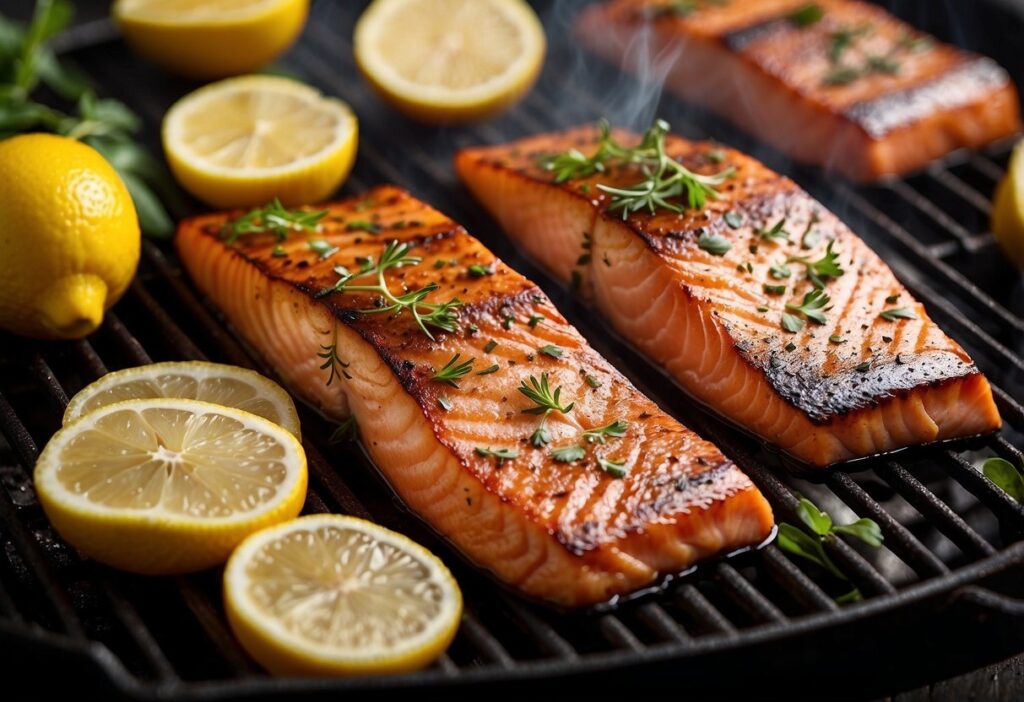
Grilling salmon perfectly requires a well-prepared grill. Make sure to choose the right type of grill, gather the necessary tools, and preheat the grill to the perfect temperature for cooking salmon.
Types of Grills
There are mainly two types of grills you can use: gas grills and charcoal grills.
- Gas grills offer precise temperature control and are easier to manage. They preheat quickly and maintain consistent heat.
- Charcoal grills provide a smoky flavor that many people love. They take longer to preheat and control the temperature but can reach higher temperatures for a good sear.
Knowing your grill type helps you manage the heat and cooking time better.
Grilling Tools Needed
To grill salmon successfully, you need these essential tools:
- Grill brush: Use it to scrape off any residue from previous use.
- Tongs and metal spatula: These are handy for flipping and moving the salmon without breaking it.
- Fish spatula: This is thinner and more flexible, perfect for handling delicate fish.
- Foil: Helps prevent fish from sticking to the grill and makes cleanup easier.
Using the right tools ensures your salmon cooks evenly and retains its shape.
Preheating for Perfect Heat
Preheating your grill is crucial for achieving the perfect cook on your salmon.
- For a gas grill, preheat to medium-high heat (375°F to 400°F). This takes about 10-15 minutes.
- If you use a charcoal grill, wait until the coals are covered with white ash and the temperature reaches around 450°F to 500°F.
Preheating ensures even cooking and helps create beautiful grill marks on your salmon. Make sure your grill is hot before placing the fish skin-side down for the best results. Adjust the heat as needed and keep an eye on the cooking time.
Grilling Techniques
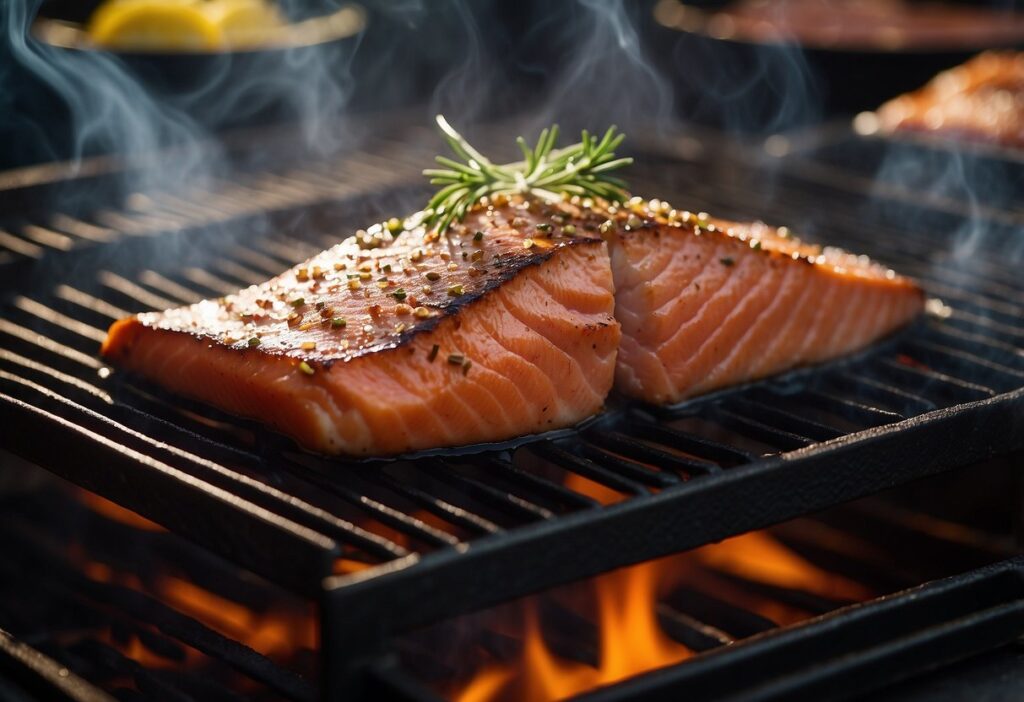
When grilling salmon, you can use various methods to achieve the perfect texture and flavor. This includes understanding the differences between direct and indirect grilling, using grilling planks, and cooking with foil.
Direct Vs. Indirect Grilling
Direct grilling means placing the salmon directly over the heat source, such as charcoal or a gas grill. This method sears the fish quickly, giving it a nice crust. Cook the fish skin-side down first and keep the lid closed to retain heat. Ideal grill time ranges from 6 to 8 minutes per inch of thickness.
Indirect grilling, on the other hand, involves placing the fish away from the heat source. This method is slower and cooks the salmon evenly without burning the outside. Use this method for thicker fillets or whole salmon to avoid overcooking. Always monitor the internal temperature, aiming for 145°F.
Using a Grilling Plank
A grilling plank, usually made of cedar, adds a smoky flavor to your salmon. Soak the plank in water for at least an hour before grilling. This prevents it from catching fire and allows it to steam the fish. Place your salmon on the soaked plank skin-side down.
With the lid closed, cook the salmon over medium heat—around 375 to 400 degrees—until it reaches the desired internal temperature. This method keeps the fish moist and infuses it with a delicious, smoky flavor. Using a plank also helps avoid sticking and makes cleanup easier.
Grilling with Foil
Grilling salmon in foil packets offers a foolproof way to keep the fish moist. Start by laying a large piece of foil down and spraying it with cooking spray or drizzling it with olive oil. Place your salmon in the center, seasoning to taste. You can also add vegetables and herbs for additional flavor.
Fold the edges of the foil to create a sealed packet, then place it on the grill. Cook over medium-high heat (375 to 400 degrees) for about 10-15 minutes, depending on the thickness. The skin-side down technique is crucial, as it prevents sticking and allows for even cooking.
Using these techniques, you can master the art of grilling salmon, ensuring it turns out delicious and perfectly cooked every time.
Mastering the Flavor
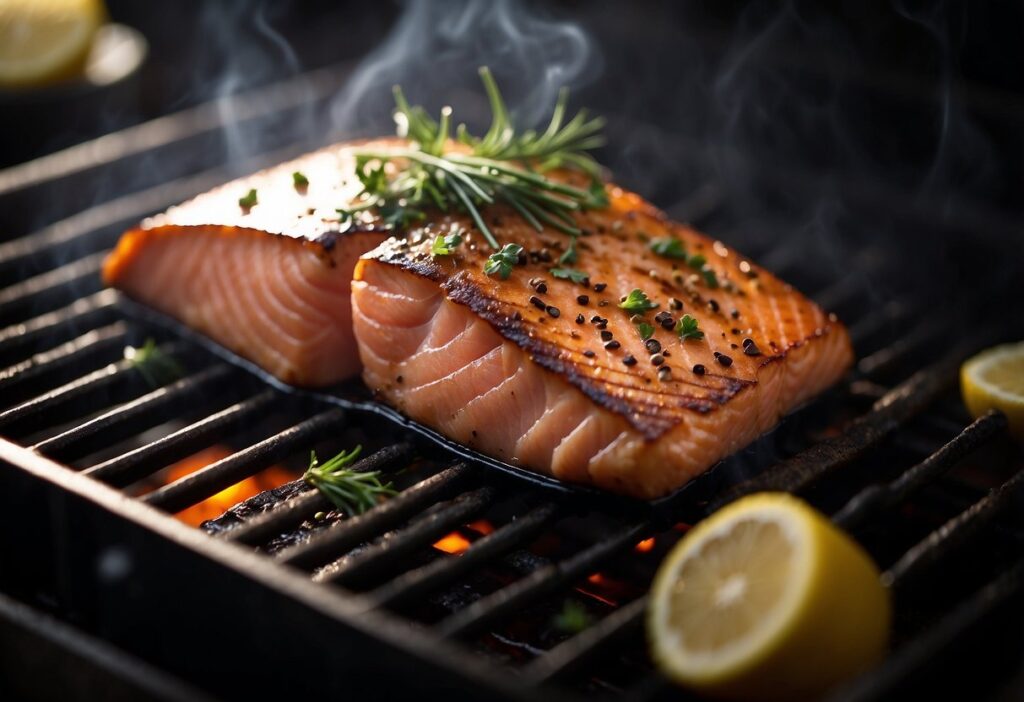
Enhancing the flavor of your grilled salmon involves selecting the right seasonings, glazes, and methods to add smoke. Attention to detail in these areas can turn a good dish into an amazing one.
Seasonings and Spices
To boost the flavor of your salmon, start with basic seasonings like kosher salt and black pepper. These two staples lay a solid foundation. Add depth with garlic powder and smoked paprika for a slightly smoky taste.
Consider incorporating some unique spice blends specific to a grilled salmon recipe. For example, a mixture of brown sugar, black pepper, and a pinch of cayenne pepper creates a sweet and spicy profile.
Salmon seasoning like lemon zest or dill can also enhance the natural flavors. Give your salmon a gentle rub with these seasonings before placing it on the grill for the best results.
Glazes and Marinades
Marinating salmon can profoundly impact its taste. A good marinade combines oil, acid, and seasonings. Common acidic ingredients include lemon juice or vinegar which help tenderize the fish while adding a zesty flavor.
For a delicious glaze, mix honey or maple syrup with Dijon mustard and soy sauce. This blend creates a sweet and tangy coating. Garlic and ginger are also great additions to a marinade, providing additional warmth and complexity.
Allow your salmon to marinate for at least 30 minutes, but no more than an hour to avoid overpowering the fresh fish flavor. Avoid excessive sugar to prevent burning.
Adding Smoke and Sizzle
Incorporating a smoky flavor during grilling adds a new dimension to your salmon. Using wood chips like hickory or applewood can infuse the fish with a rich, smoky flavor. Soak the wood chips in water for about 30 minutes to ensure they smolder rather than burn.
Place the soaked chips directly on the charcoal if you have a charcoal grill, or in a smoker box for a gas grill. Close the grill lid to allow the smoke to circulate around the salmon.
If you like a sizzled finish, preheat your grill to medium-high heat (around 375-400 degrees F). This temperature helps caramelize the exterior of the salmon, giving it a crispy texture while keeping the inside moist. Remember to oil the grill grates to prevent sticking and achieve perfect grill marks.
Cooking to Perfection
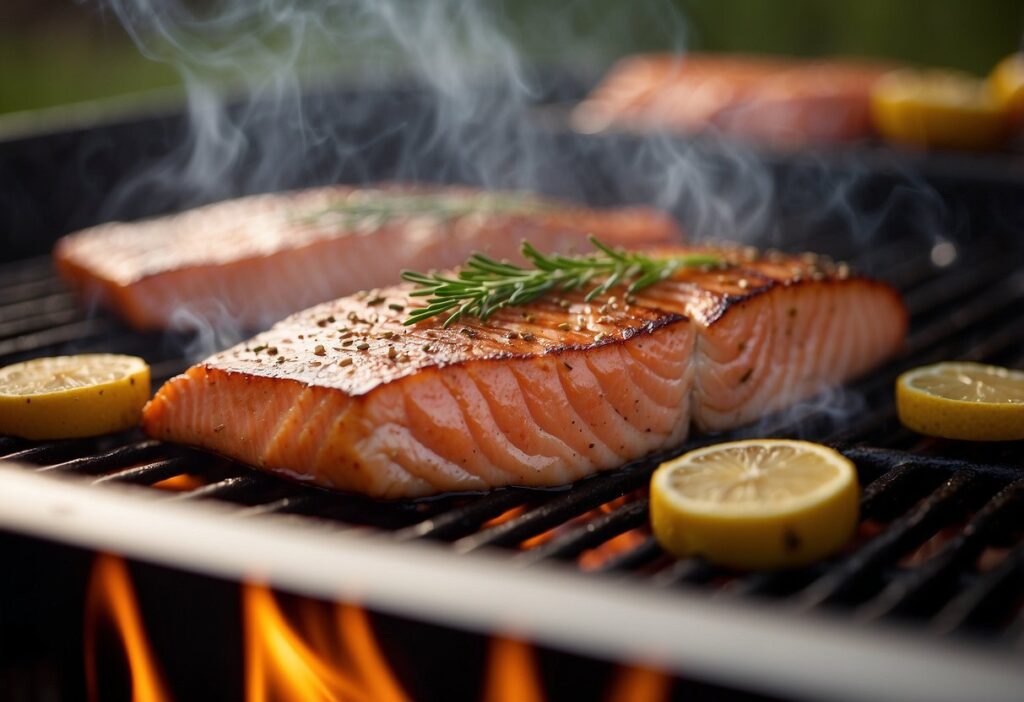
Grilling salmon to perfection involves determining when it is properly cooked and allowing it to rest for maximum moisture retention. Understanding internal temperatures and cooking times ensures a juicy, flaky texture.
Determining Doneness
To achieve the desired doneness, you must monitor the internal temperature. Use a meat thermometer and check that the internal temperature of the salmon reaches 145°F (62.8°C) as recommended by the FDA. Insert the thermometer into the thickest part of the fillet for an accurate reading.
The color of the flesh should turn opaque, and it should flake easily when pressed with a fork. Each inch of salmon generally needs 6-8 minutes of cook time. For a 1-inch thick fillet, grill for 3-4 minutes per side. Cooking salmon skin-side down helps provide even heat distribution and keeps the flesh moist.
Resting for Moisture Retention
After removing the salmon from the grill, allow it to rest for a few minutes. This step is key to retaining moisture and ensuring a juicy, flaky texture. Place the grilled salmon on a plate and cover it loosely with foil.
Resting helps the juices redistribute throughout the fillet, which enhances flavor and prevents dryness. Aim to rest the salmon for at least 5 minutes before serving. This simple step makes a significant difference in the texture and overall eating experience, giving you a perfectly cooked, succulent piece of fish.
For more detailed instructions on how to achieve this, you can refer to how to grill salmon perfectly.
Healthy Eating
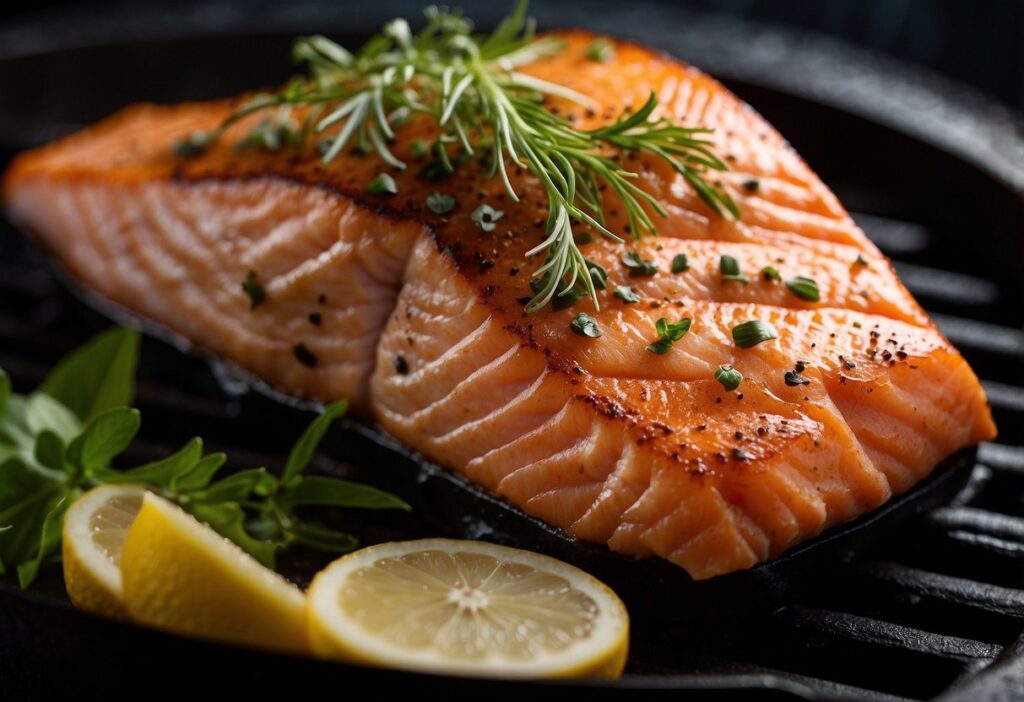
Salmon is a powerhouse of nutrients and fits well into a balanced diet. In this section, you will learn about its nutritional benefits and how to incorporate it into your meals.
Nutritional Benefits of Salmon
Salmon is rich in omega-3 fatty acids, which are good for heart health. Each serving offers a high amount of protein, making it an excellent choice for muscle repair and growth. It is also low in saturated fat compared to other meats.
A 3-ounce serving of salmon contains about 150-200 calories, making it a nutritious option that helps you feel full without overeating. Additionally, salmon is a good source of vitamins like B12 and D, as well as minerals such as iron and zinc. This makes it a well-rounded choice for anyone looking to improve their diet.
Salmon in a Balanced Diet
Incorporating salmon into your meals can be simple. Grill it and add it to a salmon salad for a light, nutritious lunch. You can also use it as the main protein in your dinner.
To keep it healthy, pair salmon with plenty of fiber-rich vegetables such as broccoli or leafy greens. This combination ensures you get a balanced mix of proteins, vitamins, and minerals. You can also try different herbs and spices to keep your meals interesting without adding extra calories.
Salmon fits well into many dietary plans. Whether you follow a Mediterranean diet, a low-carb plan, or just want a healthy protein option, salmon can be a versatile and delicious addition.
Serving and Presentation
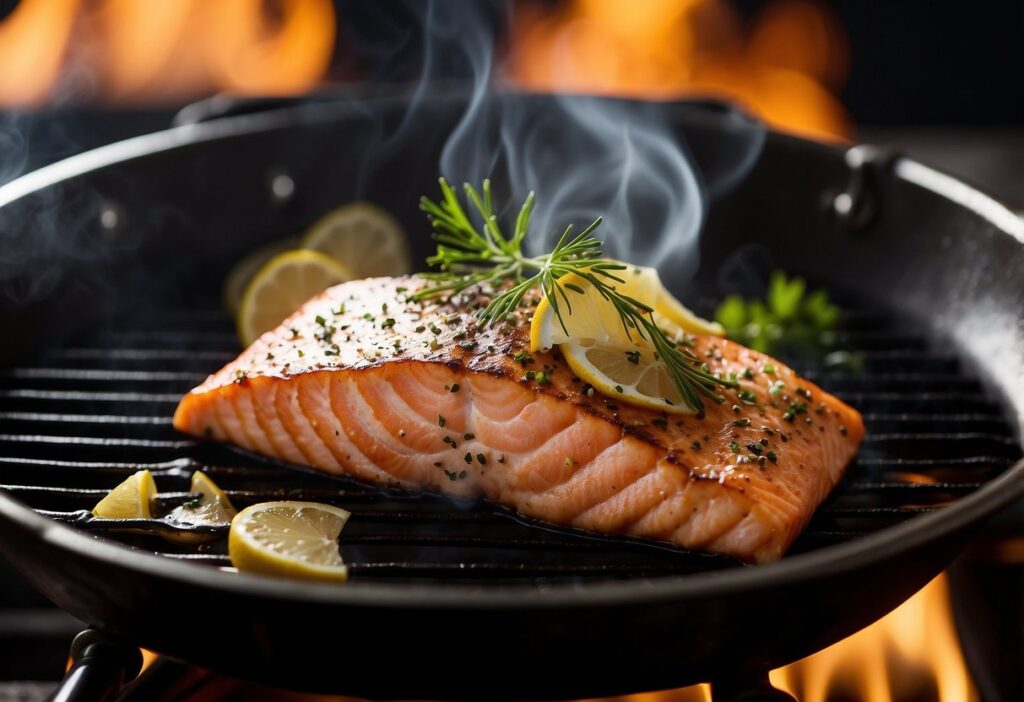
When it comes to serving grilled salmon, presentation and accompaniments are key. Here are specific tips for elevating your dish and making it visually appealing and enticing.
Accompaniments
Pairing grilled salmon with the right sides can enhance its flavors and provide a balanced meal. Consider serving it with fresh veggies like grilled asparagus, which adds a nice crunch and complements the smoky taste of the salmon. A light, refreshing salad with ingredients like tomatoes, cucumbers, and a lemon vinaigrette can brighten up the plate.
Another great option is a simple quinoa or rice pilaf, which provides a neutral base that allows the salmon’s flavor to shine. For a summer twist, include seasonal produce like roasted corn or a mango salsa. These accompaniments not only add variety but also keep the meal light and enjoyable.
Plating Techniques
Plating your grilled salmon thoughtfully can make a big difference in the dining experience. Start by placing the salmon fillet slightly off-center. This creates a more dynamic and professional look. Arrange your accompaniments around the salmon to create balance and make the dish visually appealing.
For a touch of elegance, consider using a drizzle of a vibrant sauce, like a dill or citrus sauce, around the plate. Garnish with fresh herbs such as parsley or dill to add color and a hint of freshness.
Use a white plate to make the salmon and sides stand out. For an elevated presentation, you can also use small ramekins for sauces or salsas, keeping the plate tidy and organized. These techniques help ensure that the presentation is as impressive as the flavor.
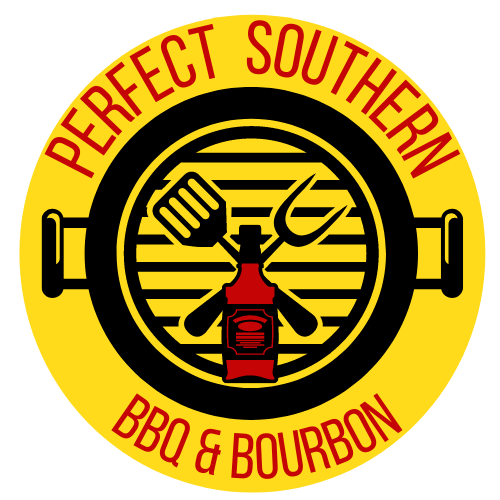
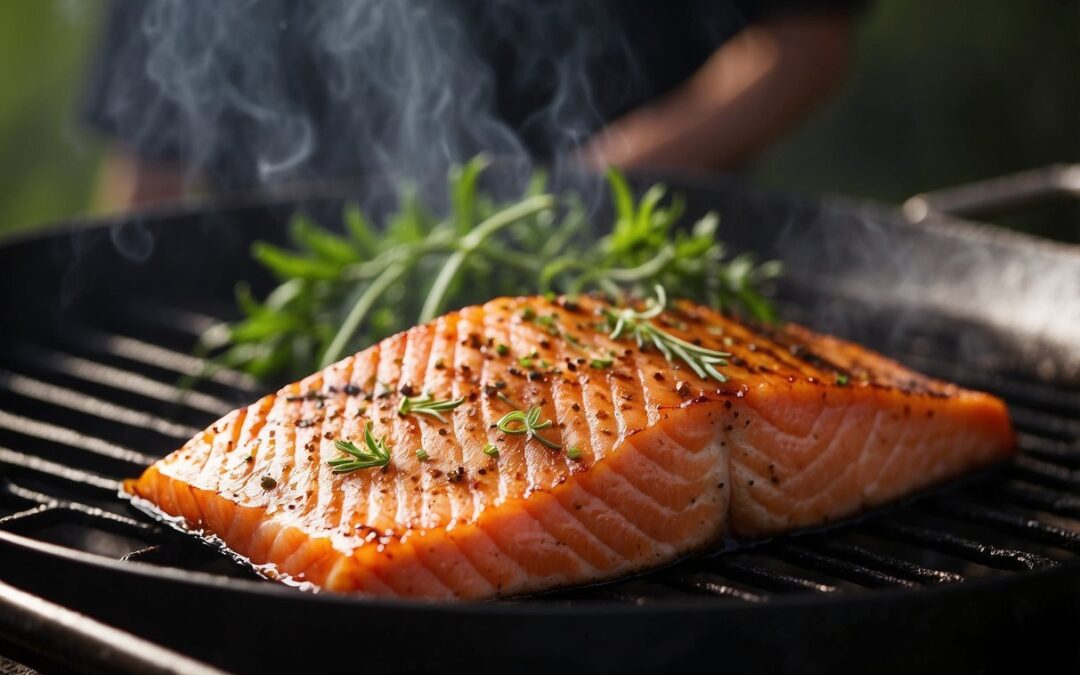
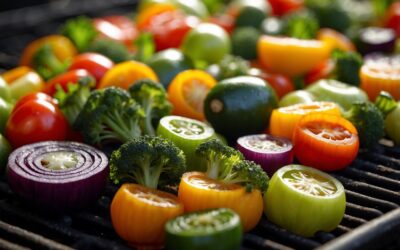
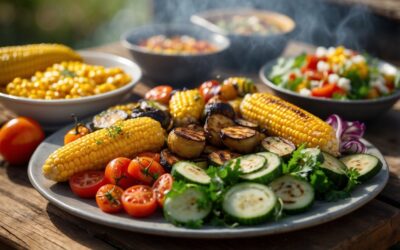
Trackbacks/Pingbacks